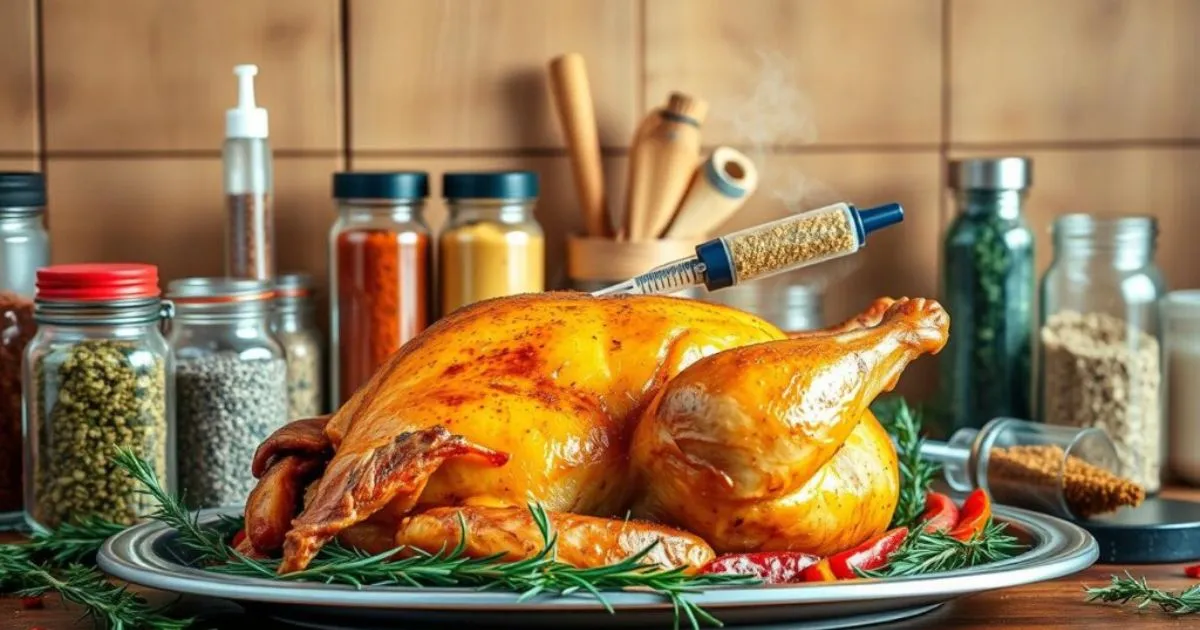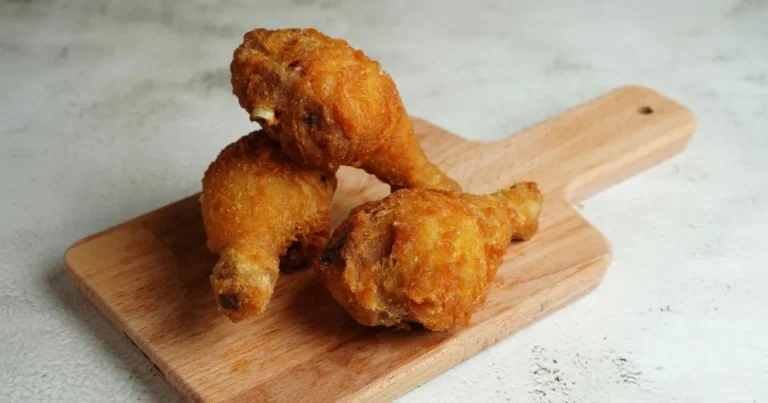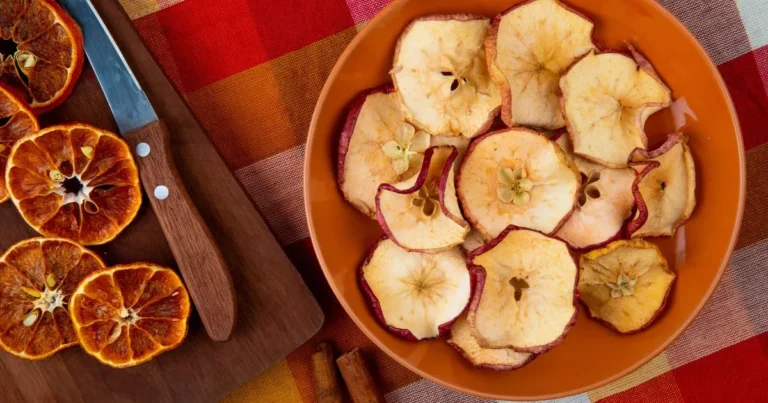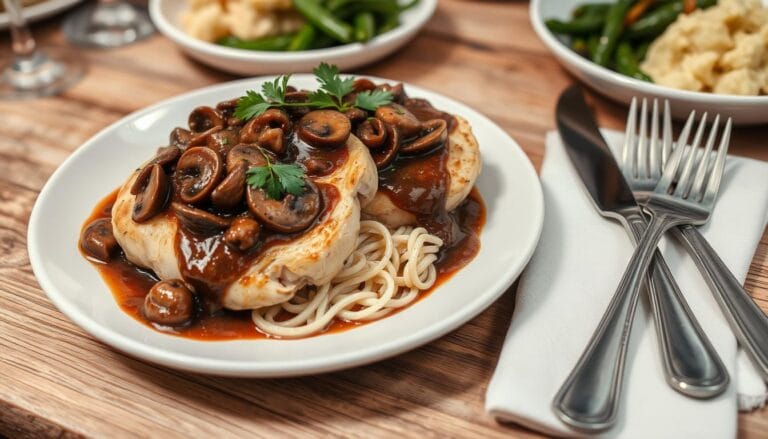Easy Fried Turkey Seasoning Injection Recipe for Crispy Perfection
When I first tasted a perfectly seasoned Fried Turkey Seasoning, my holiday meals changed forever. It’s magical to turn an ordinary turkey into a crispy, flavorful masterpiece. Everyone at the table wants more.
This guide will teach you how to make a delicious fried turkey. You’ll learn to get that crispy outside and juicy, seasoned inside. It’s all about the flavor and texture.
A fried turkey seasoning injection recipe is more than a cooking method—it’s an art. It makes your holiday feast unforgettable. Whether you’re experienced or new to turkey frying, this method can make your Thanksgiving dinner special.
Table of Contents
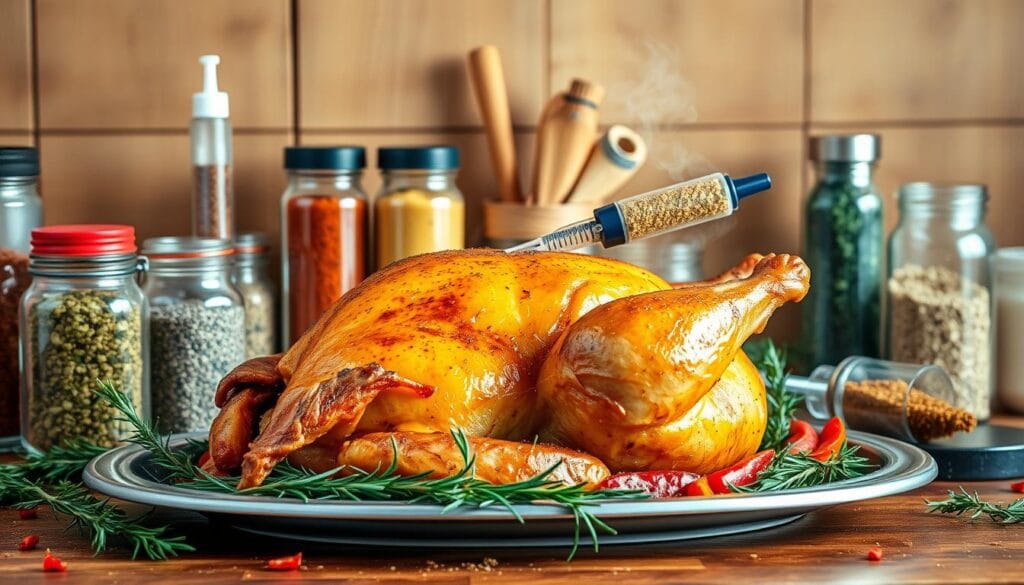
Understanding the Art of Turkey Injection Marinades
Learning how to use turkey injection marinades can change how you cook poultry. It’s different from just marinating the outside. Injection methods let you put flavor right into the meat, making your dish taste better and more even.
Benefits of Injecting vs Traditional Marinating
Using an injection marinade has many benefits for cooking poultry:
- Flavor goes deeper into the meat
- Seasonings spread out more evenly
- It absorbs faster than surface marinating
- It helps keep the turkey moist while it cooks
“Injection marinades are like a flavor expressway directly into your turkey’s core.” – Professional Chef
Essential Equipment for Turkey Injection
To inject your turkey well, you’ll need some special tools:
- Meat injector with a big needle
- Stainless steel mixing bowl
- Whisk for mixing the marinade
- Clean kitchen towels
Types of Injection Marinades
Try different marinades to make your turkey taste amazing:
- Butter-based marinades for a rich taste
- Herb-infused liquid marinades
- Spicy Cajun-style injection blends
- Citrus and wine-based marinades
Picking the right marinade can make your turkey a hit with everyone.
Essential Ingredients for the Perfect Turkey Injection
Creating a mouth-watering fried turkey starts with the right ingredients. Your butter injection and brine are key. They turn an ordinary turkey into a culinary masterpiece.
The foundation of a great turkey injection is high-quality ingredients. Butter is crucial for keeping the turkey moist and flavorful. Not all butter is created equal – choose unsalted butter for the best results.
Key Ingredients for Your Turkey Injection
- Unsalted butter (primary base for injection)
- Kosher salt
- Fresh herbs (rosemary, thyme, sage)
- Garlic powder
- White wine or chicken stock
Brine preparation is also key for flavor and moisture. A good brine tenderizes the meat and adds deep flavors. Create a saltwater solution with aromatics to boost your injection marinade.
“The key to a perfect fried turkey is in the details of your injection and brine.” – Professional Chef
Flavor Boosting Tips
- Use fresh ingredients for maximum flavor intensity
- Experiment with regional spice blends
- Balance salt and herbs carefully
- Ensure butter is at room temperature for smooth injection
Your butter injection mixture should be smooth and well-integrated. This ensures even distribution throughout the turkey. Strain your mixture to remove solid particles that might clog your needle. This way, you get a perfect application every time.
Step-by-Step Fried Turkey Seasoning Injection Recipe
Making the perfect fried turkey means mastering seasoning injection. This guide will show you how to make a delicious fried turkey seasoning injection. It will take your holiday meal to the next level.
Base Marinade Preparation
Your fried turkey seasoning injection begins with a strong base marinade. Choose top-notch ingredients that soak deep into the turkey. For a real flavor, use these main parts:
- Melted unsalted butter
- Chicken broth or white wine
- Worcestershire sauce
- Fresh herbs like thyme and rosemary
Spice Mixture Components
Cajun spices are key for a memorable injection marinade. Your spice mix should have a mix of flavors that go well with the turkey’s taste:
| Spice | Quantity | Purpose |
|---|---|---|
| Paprika | 2 tablespoons | Adds color and mild heat |
| Garlic powder | 1 tablespoon | Provides depth of flavor |
| Cayenne pepper | 1 teaspoon | Introduces spicy kick |
| Black pepper | 1 tablespoon | Enhances overall seasoning |
Combining and Mixing Instructions
Making the perfect fried turkey seasoning injection needs care. Follow these steps for a smooth, well-blended marinade:
- Warm the butter in a saucepan over low heat
- Whisk in chicken broth and Worcestershire sauce
- Gradually add measured cajun spices
- Blend thoroughly until completely incorporated
“The secret to an incredible fried turkey is in the injection – it’s all about layering flavors!” – Chef Michael Rodriguez
Pro tip: Always strain your injection marinade to remove any solid spice particles that might clog your injection needle.
Best Practices for Deep Frying Your Injected Turkey
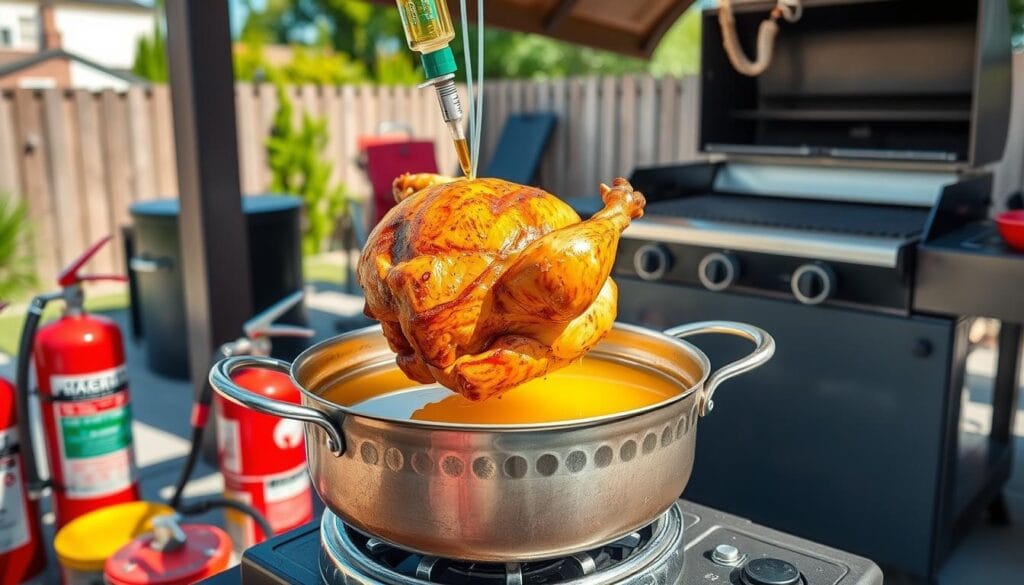
Deep frying a turkey needs precision and skill. The right turkey fryer can make your meal crispy and flavorful. It’s important to choose the right equipment and know how to deep fry.
Before you start, make sure you have these tools:
- Outdoor turkey fryer with sturdy base
- Thermometer for oil temperature
- Long-handled utensils
- Fire extinguisher
- Heat-resistant gloves
Peanut oil is the best choice for deep frying. It has a high smoke point and a neutral taste. Keep the oil between 325-350 degrees Fahrenheit for crispy skin.
“Safety first when deep frying – never leave your turkey fryer unattended.” – Professional Chef Recommendation
How you fry the turkey affects its quality. Lower the turkey into the hot oil slowly to avoid splatters. Keep the temperature steady and watch the time – about 3-4 minutes per pound for a great bird.
| Turkey Weight | Estimated Frying Time | Internal Temperature |
|---|---|---|
| 10-12 lbs | 30-36 minutes | 165°F |
| 13-15 lbs | 39-45 minutes | 165°F |
| 16-18 lbs | 48-54 minutes | 165°F |
After frying, let the turkey rest for 20 minutes. This helps the juices spread, making the turkey juicy and flavorful. Remember, patience is key for a perfectly fried turkey.
Cajun-Style Variations for Bold Southern Flavor
Take your fried turkey to new heights with authentic Cajun spices. These spices bring the lively spirit of Louisiana right to your table. Southern cooking traditions add a thrilling twist to your marinade, turning a simple turkey into a memorable feast.
Cajun cuisine is known for its bold flavors that excite your taste buds. Your marinade can be a playground for these amazing flavors.
Traditional Cajun Spice Blend
A classic Cajun spice blend includes:
- Paprika for rich color and mild heat
- Cayenne pepper for signature spiciness
- Garlic powder for depth
- Dried oregano
- Dried thyme
Heat Level Adjustments
Not everyone likes the same spice level. You can tweak the cayenne pepper in your marinade. Start with a little and add more until it’s just right for you.
Regional Seasoning Variations
Different parts of Louisiana have their own Cajun spice styles. Some like more pepper, while others prefer herbs. Trying these variations can make your marinade truly yours.
“In Louisiana, cooking isn’t just food—it’s a celebration of culture and flavor.” – Southern Culinary Tradition
Safety Tips for Turkey Injection and Frying
Preparing a delicious fried turkey is more than just cooking. Safety is key when using a turkey fryer and cooking oil. Taking the right steps can prevent accidents and make cooking a success.
Choose a flat, outdoor spot for your turkey fryer. Make sure it’s away from buildings, trees, and anything that can catch fire. Keep kids and pets far away while you cook.
- Always keep a fire extinguisher nearby when using a turkey fryer
- Thaw your turkey completely before frying to prevent dangerous oil splattering
- Wear protective gear like long sleeves, gloves, and safety glasses
Handling cooking oil is very dangerous. Never overfill your turkey fryer with oil. This can lead to dangerous spills and fires. Use the water displacement method to find the right oil level before heating.
“Safety first makes cooking fun and enjoyable!” – Professional Chef Recommendation
Keeping the temperature right is key when deep frying. Use a meat thermometer to make sure your turkey is at 165°F. Keep the oil between 325-350°F for the best results.
- Check turkey fryer equipment for damage before use
- Clean the fryer thoroughly after each use
- Store cooking oil and turkey fryer in a cool, dry place
By following these safety tips, you’ll make a tasty fried turkey. And you’ll keep yourself and your loved ones safe from kitchen dangers.
Common Mistakes to Avoid When Injecting Turkey
Getting a tasty fried turkey seasoning injection recipe right needs focus and detail. Even skilled cooks can make mistakes that ruin their dish.
Learning to inject turkey well means knowing what to avoid. Here are the top mistakes that can mess up your meal.
Mastering the Proper Injection Technique
Using your fried turkey seasoning injection recipe right is key. Here are some common mistakes to steer clear of:
- Injecting too deeply into the meat, which can cause uneven flavor distribution
- Using a dull or improperly sized injection needle
- Failing to move the needle around to spread the marinade evenly
Navigating Temperature Control Challenges
Temperature is vital for cooking poultry safely and tasty. Be careful of these temperature mistakes:
| Temperature Issue | Potential Consequence | Prevention Tip |
|---|---|---|
| Cold Turkey | Uneven seasoning absorption | Allow turkey to reach room temperature before injection |
| Inconsistent Oil Temperature | Greasy or undercooked meat | Maintain consistent 350°F during frying |
Preventing Storage and Preparation Errors
Right storage and prep are key for a safe and tasty turkey:
- Always thaw turkey completely before injection
- Refrigerate injected turkey immediately
- Use injected poultry within 24-48 hours
“The difference between a good and great fried turkey is often in the details of preparation.” – Professional Chef
Pro tip: Always clean your injection tools well between uses. This prevents bacteria and keeps your turkey flavor pure.
Timing and Temperature Guidelines
Mastering the timing and temperature for deep frying a turkey is key to a delicious Thanksgiving centerpiece. Your success depends on precise preparation and careful cooking techniques.
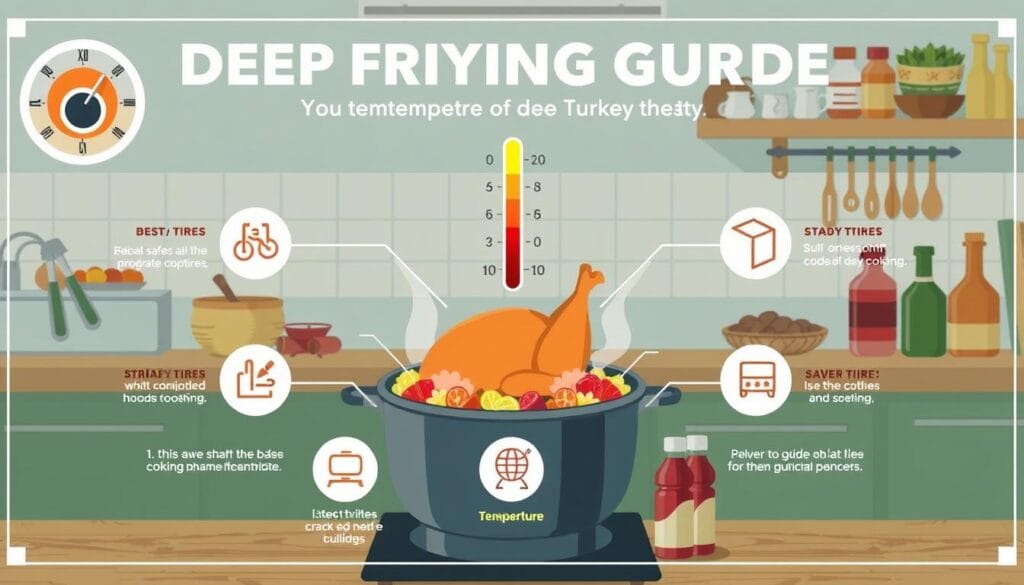
Before deep frying, prepare your turkey with plenty of time to spare. Allow 12-24 hours for the injection marinade to fully penetrate the meat. This resting period ensures maximum flavor absorption.
Critical Temperature Guidelines
- Turkey internal temperature: 165°F (74°C)
- Oil temperature for deep frying: 350°F (175°C)
- Recommended cooking time: 3-4 minutes per pound
| Turkey Weight | Approximate Cooking Time | Oil Temperature |
|---|---|---|
| 10-12 lbs | 30-40 minutes | 350°F |
| 13-15 lbs | 45-55 minutes | 350°F |
| 16-18 lbs | 60-70 minutes | 350°F |
When deep frying for Thanksgiving, always use a reliable meat thermometer to check the internal temperature. Never rely solely on cooking time. Remove the turkey from the oil when it reaches 165°F at the thickest part of the breast and thigh.
“Patience and precision are the secret ingredients to a perfectly fried turkey.” – Professional Chef
Plan your cooking schedule carefully. Give yourself extra time for preparation, and ensure your turkey is completely thawed before deep frying. A frozen or partially frozen turkey can cause dangerous oil splattering.
Complementary Rubs and External Seasonings
To take your fried turkey to the next level, think beyond just injecting it. Adding external seasonings can turn your dish into a true masterpiece. The right mix of dry rubs and cajun spices can make a huge difference in taste.
When you’re getting ready to cook your turkey, keep these tips in mind for the best flavor:
- Create depth with multi-layered seasoning techniques
- Balance brine-based moisture with robust dry rub flavors
- Select complementary spice blends
Crafting the Perfect Dry Rub Combination
A great dry rub can really boost your turkey’s flavor. Mix cajun spices with traditional herbs for a rich taste experience.
| Ingredient | Quantity | Flavor Profile |
|---|---|---|
| Paprika | 2 tbsp | Smoky base |
| Cayenne Pepper | 1 tsp | Heat element |
| Dried Thyme | 1 tbsp | Herbal notes |
Application Techniques
Your brine and injection prep lay the groundwork. But it’s the external seasonings that really make it shine. Gently massage your dry rub under the skin for the best flavor.
“The secret is layering flavors – each technique builds upon the last.” – Professional Chef
Try out different cajun spices and ways to apply them to find your favorite turkey seasoning method. Remember, it’s all about precision and patience for amazing results.
Serving and Storage Recommendations
Your fried turkey is the star of the Thanksgiving feast. To keep it delicious, follow these serving and storage tips.
Carving and Presentation Strategies
Carve your turkey with a sharp knife, cutting against the grain. This keeps the meat tender and shows off the juicy marinade.
- Use a sharp, long-bladed carving knife
- Cut thin, even slices for best presentation
- Arrange slices on a warm platter to retain heat
Storage Guidelines
Storing leftover fried turkey is key to keeping it safe and tasty.
| Storage Method | Duration | Recommended Technique |
|---|---|---|
| Refrigeration | 3-4 days | Store in airtight container |
| Freezing | 2-3 months | Wrap tightly in freezer paper |
“The secret to great leftovers is protecting the turkey’s moisture from the moment you finish cooking.” – Professional Chef
Reheating Without Losing Moisture
To reheat your turkey without drying it, use low heat. Covering it with foil and warming it slowly in the oven keeps it juicy.
- Preheat oven to 325°F
- Place turkey in a baking dish
- Cover with aluminum foil
- Heat until internal temperature reaches 165°F
Pro tip: Add a small amount of chicken broth to the baking dish to help maintain moisture during reheating.
Conclusion
Making the perfect fried turkey seasoning injection recipe is like an art. It turns simple holiday meals into amazing dishes. By learning how to prepare marinades and inject flavors, you can make your turkey truly special.
This guide has given you expert tips for a delicious, crispy turkey. It’s all about choosing the right ingredients, mastering injection methods, and keeping the frying temperature just right. Every step you’ve learned helps make your turkey rich and flavorful, impressing your guests.
Remember, getting better at fried turkey recipes takes practice. Feel free to try out different marinades and spice mixes. Start with the basics and then add your own twist. The more you try, the better you’ll get at making a tasty, perfectly seasoned turkey.
Now, you’re ready to be the hero of any party. With your knowledge of marinades, injection techniques, and safety, you can make a dish that everyone will love. They’ll all want to know your secret recipe.
FAQ
How long should I let the turkey sit after injecting the marinade?
Let the turkey rest in the fridge for 12-24 hours after injecting. This lets the marinade soak deep into the meat. It makes the turkey taste better and season evenly.
Can I use the same injection marinade recipe for different types of poultry?
The basic method works for many birds. But, you might need to adjust the spice for different sizes. Smaller birds like chicken need less marinade and milder flavors than big turkeys.
What is the recommended oil temperature for deep frying an injected turkey?
Fry at 325-350°F (163-177°C). This temperature makes the outside crispy and keeps the inside juicy. It also stops the turkey from getting too greasy.
How much seasoning injection should I use for a typical-sized turkey?
For a 12-14 pound turkey, use 1/2 to 3/4 cup of marinade. The exact amount depends on the turkey’s size and how strong you like the flavor.
Are there any safety concerns with injecting and deep frying a turkey?
Deep frying a turkey needs care. Make sure the turkey is dry and not wet. Fry outside, away from things that can catch fire. Always have a fire extinguisher ready.
Can I make the injection marinade ahead of time?
Yes, you can make it 2-3 days before. Keep it in the fridge in an airtight container. Warm it up gently before using to mix the ingredients well.
What’s the best way to inject the marinade into the turkey?
Use a meat injector with many holes. Inject in the breast, thighs, and legs. Insert the needle at an angle and slowly release the marinade while pulling out to spread it evenly.
How do I prevent the turkey from becoming too salty when using an injection marinade?
Use low-sodium ingredients and measure carefully. Taste the marinade before injecting. Avoid too much salt. Use herbs and spices for flavor without extra salt.
Can I use a Cajun-style injection for a non-spicy version?
Yes! You can make a Cajun-style marinade less spicy. Just cut down or remove hot spices like cayenne. Add herbs like thyme or rosemary for flavor without heat.
How long can I keep a fried injected turkey after cooking?
Keep it in the fridge for 3-4 days in an airtight container. Cool it down completely before refrigerating. Reheat well before eating.

